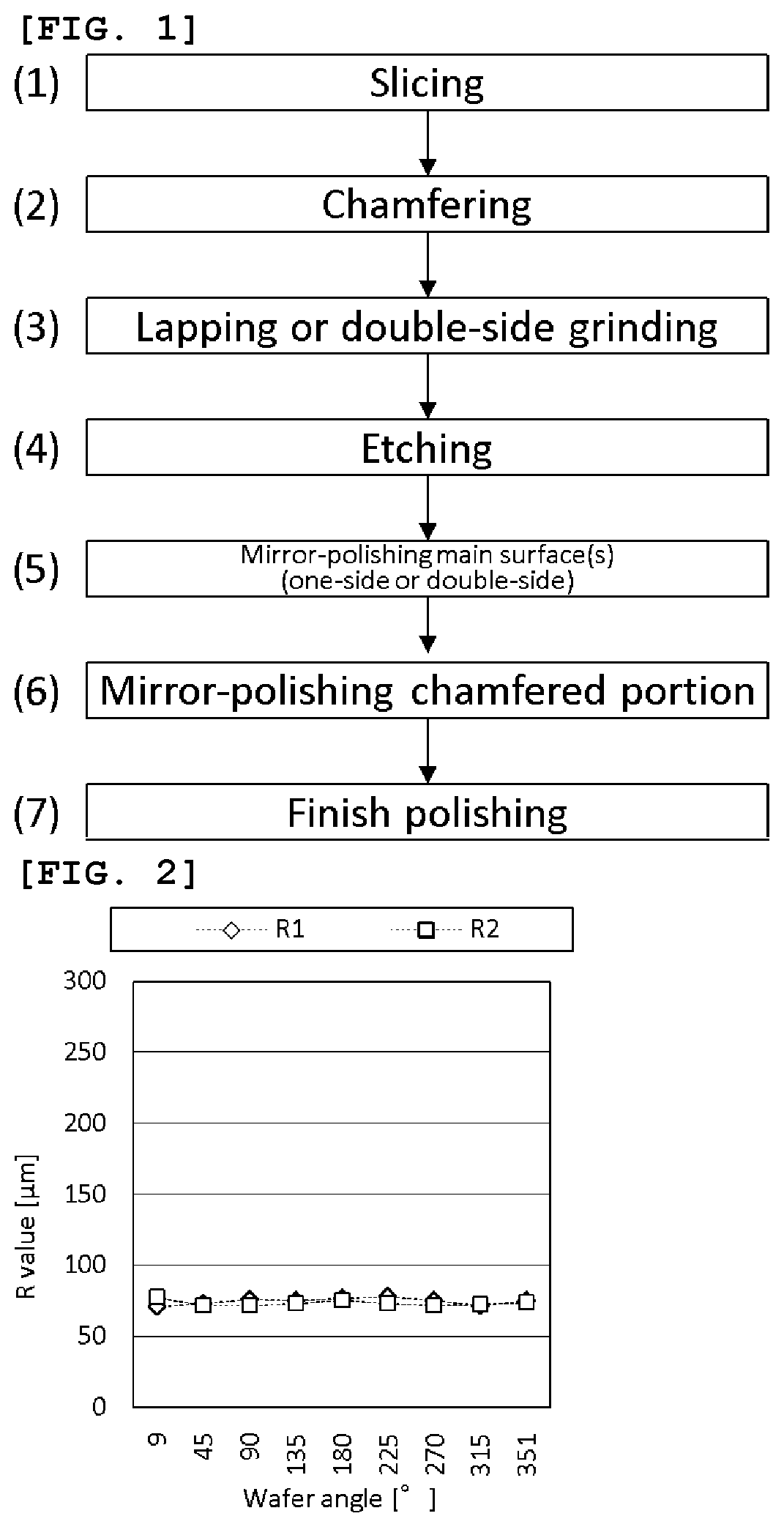Method for manufacturing wafer
a manufacturing method and wafer technology, applied in the direction of manufacturing tools, lapping machines, edge grinding machines, etc., can solve the problem of reducing the flatness of the wafer by a high etching ra
- Summary
- Abstract
- Description
- Claims
- Application Information
AI Technical Summary
Benefits of technology
Problems solved by technology
Method used
Image
Examples
example 1
[0068]A wafer was prepared as follows while the target values of R1, R2 of the final wafer product were set to 220 μm or more and 300 μm or less.
[0069]First, a single crystal silicon ingot was sliced to obtain a sliced wafer (step 1). Next, a grinding wheel was rotated at high speed. The grinding wheel used had a groove shape designed to make the chamfered cross-sectional shape dimensions of the R1 value and the R2 value within a range of 50 μm or more and 100 μm or less. After the slicing step, a circumferential edge portion of the silicon wafer held on a holding stage was brought into contact with the grinding wheel, and chamfered by rotating the wafer (step 2).
[0070]At this point (immediately after the chamfering in step 2), the chamfered cross-sectional shape dimensions of the R1 value and the R2 value were measured at nine spots inside the circumference of the silicon wafer, specifically, nine positions at intervals of 45°, including 9° and 351°, with respect to a notch. FIG. 2...
example 2
[0075]A sliced wafer was obtained by the same method as in Example 1, and then chamfered with a grinding wheel by the same method as in Example 1. The grinding wheel used had a groove shape designed to make the chamfered cross-sectional shape dimensions of the R1 value and the R2 value within 150 to 200 μm.
[0076]Next, the double-side grinding, alkali etching, double-side mirror-polishing, and chamfered-portion mirror-polishing were successively performed by the same method as in Example 1.
[0077]As in Example 1, after the chamfering step, after the alkali etching step, and after the chamfered-portion mirror-polishing step, the chamfered cross-sectional shape dimensions were measured at the same positions as in Example 1 and under the same conditions as the above measurement conditions. FIG. 6 shows the chamfered cross-sectional shape dimensions of the R1 value and the R2 value after the chamfering step. FIG. 7 shows the chamfered cross-sectional shape dimensions of the R1 value and t...
PUM
| Property | Measurement | Unit |
|---|---|---|
| thickness | aaaaa | aaaaa |
| temperature | aaaaa | aaaaa |
| shape | aaaaa | aaaaa |
Abstract
Description
Claims
Application Information
 Login to View More
Login to View More - R&D
- Intellectual Property
- Life Sciences
- Materials
- Tech Scout
- Unparalleled Data Quality
- Higher Quality Content
- 60% Fewer Hallucinations
Browse by: Latest US Patents, China's latest patents, Technical Efficacy Thesaurus, Application Domain, Technology Topic, Popular Technical Reports.
© 2025 PatSnap. All rights reserved.Legal|Privacy policy|Modern Slavery Act Transparency Statement|Sitemap|About US| Contact US: help@patsnap.com



